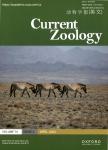Sonicating bees demonstrate flexible pollen extraction without instrumental learning
作者机构:Department of Organismic and Evolutionary Biology Harvard University Cambridge MA USA Arnold Arboretum Harvard University Boston MA USA Department of Ecology and Evolutionary Biology University of Arizona Tucson AZ USA Department of Neurobiology Physiology and Behavior University of California at Davis Davis CA USA Department of Biology and eScience Institute University of Washington Seattle WA USA Department of Biological Sciences University of Pittsburgh Pittsburgh PA USA
出 版 物:《Current Zoology》 (动物学报(英文版))
年 卷 期:2019年第65卷第4期
页 面:425-436页
核心收录:
学科分类:0710[理学-生物学] 07[理学] 0905[农学-畜牧学] 0906[农学-兽医学]
基 金:Graduate and Professional Student Council of the University of Arizona Komen Endowed Chair National Science Foundation, NSF, (CAREER IOS-1253677) Directorate for Biological Sciences, BIO, (1253677) Air Force Office of Scientific Research, AFOSR, (FA9550-14-1-0398) Alfred P. Sloan Foundation Gordon and Betty Moore Foundation, GBMF Washington Research Foundation, WRF National Defense Science and Engineering Graduate, NDSEG
主 题:Bombus impatiens buzz pollination foraging innate behavior learned behavior Solanum
摘 要:Pollen collection is necessary for bee survival and important for flowering plant reproduction, yet if and how pollen extraction motor routines are modified with experience is largely unknown. Here, we used an automated reward and monitoring system to evaluate modification in a common pollen-extraction routine, floral sonication. Through a series of laboratory experiments with the bumblebee, Bombus impatiens, we examined whether variation in sonication frequency and acceleration is due to instrumental learning based on rewards, a fixed behavioral response to rewards, and/or a mechanical constraint. We first investigated whether bees could learn to adjust their sonication frequency in response to pollen rewards given only for specified frequency ranges and found no evidenee of instrumental learning. However, we found that absenee versus receipt of a pollen reward did lead to a predictable behavioral resp on se, which depe nded on bee size. Fin ally, we found some evide nee of mechanical con straints, in that flower mass affected sonication acceleration (but not frequency) through an interaction with bee size. In generalz larger bees showed more flexibility in sonication frequency and acceleration, potentially reflecting a size-based constraint on the range over which smaller bees can modify frequency and accelerati on. Overall our results show that although bees did not display instrumental learning of sonication frequency, their sonication motor routine is nevertheless flexible.



